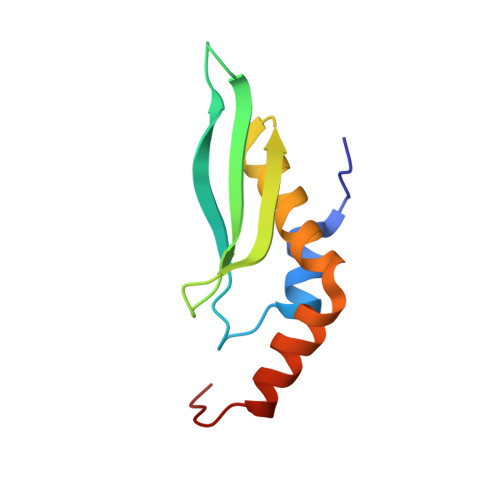Intrinsic Dynamics of an Extended Hydrophobic Core in the S. cerevisiae RNase III dsRBD Contributes to Recognition of Specific RNA Binding Sites.
Hartman, E., Wang, Z., Zhang, Q., Roy, K., Chanfreau, G., Feigon, J.(2013) J Mol Biol 425: 546-562
- PubMed: 23201338
- DOI: https://doi.org/10.1016/j.jmb.2012.11.025
- Primary Citation of Related Structures:
2LUQ - PubMed Abstract:
The Saccharomyces cerevisiae RNase III enzyme Rnt1p preferentially binds to double-stranded RNA hairpin substrates with a conserved (A/u)GNN tetraloop fold, via shape-specific interactions by its double-stranded RNA-binding domain (dsRBD) helix α1 to the tetraloop minor groove. To investigate whether conformational flexibility in the dsRBD regulates the binding specificity, we determined the backbone dynamics of the Rnt1p dsRBD in the free and AGAA hairpin-bound states using NMR spin-relaxation experiments. The intrinsic microsecond-to-millisecond timescale dynamics of the dsRBD suggests that helix α1 undergoes conformational sampling in the free state, with large dynamics at some residues in the α1-β1 loop (α1-β1 hinge). To correlate free dsRBD dynamics with structural changes upon binding, we determined the solution structure of the free dsRBD used in the previously determined RNA-bound structures. The Rnt1p dsRBD has an extended hydrophobic core comprising helix α1, the α1-β1 loop, and helix α3. Analysis of the backbone dynamics and structures of the free and bound dsRBD reveals that slow-timescale dynamics in the α1-β1 hinge are associated with concerted structural changes in the extended hydrophobic core that govern binding of helix α1 to AGAA tetraloops. The dynamic behavior of the dsRBD bound to a longer AGAA hairpin reveals that dynamics within the hydrophobic core differentiate between specific and nonspecific sites. Mutations of residues in the α1-β1 hinge result in changes to the dsRBD stability and RNA-binding affinity and cause defects in small nucleolar RNA processing invivo. These results reveal that dynamics in the extended hydrophobic core are important for binding site selection by the Rnt1p dsRBD.
Organizational Affiliation:
Department of Chemistry and Biochemistry, and Molecular Biology Institute, University of California, Los Angeles, Los Angeles, CA 90095-1569, USA.














